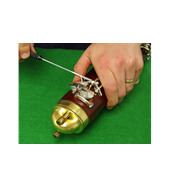Bassoon(s) of the Week: Two Short-Reaches Compared
November 21st, 2025

This week we’re taking a side-by-side look at two of the most popular short-reach bassoons. They are made by two different but well-established and -respected German bassoon makers. The Schreiber S13 and the Adler 1356 occupy a very similar place in the market. If you’re choosing between them, this direct comparison will help clarify which may suit you best.
Before We Start… What Is a Short-Reach Bassoon and Who Is It For?
A short-reach bassoon is a full-sized instrument with modified keywork designed to reduce hand stretch, because the bassoon is a relatively large instrument. The acoustical design is similar to the standard models—what changes is the ergonomics.
Typical alterations include:
- Longer left-hand thumb keys
- A repositioned and lengthened right-hand low G key
- Removal of the Bb trill key
- Other carefully-adjusted touch-pieces
Short-reach bassoons are often the ideal choice for:
- Children who have not yet grown into a standard bassoon
- Adults with smaller hands or shorter fingers
- Players with hand/finger mobility issues
Do They Sound Different?
There is no acoustic reason why a short-reach bassoon should sound different from its full-sized sibling. The bore, pads, tone holes and body are identical. Only the keywork layout changes.
In practice, however, many players find that short-reach models feel a little more free-blowing and slightly less resistant than their standard counterparts. This can make them:
- Very easy to play from the beginning
- Less tiring for smaller or younger players
Full-sized models tend to offer slightly more resistance, which can provide greater tonal stability once a player’s embouchure and breath support have developed.
Adler 1356 vs Schreiber S13
Both bassoons are the short-reach versions of their makers’ standard student instruments:
- Adler 1356 ← short-reach sibling of the Adler 1357
- Schreiber S13 ← short-reach sibling of the Schreiber S16
The comparison table below refers specifically to the instruments currently in our stock with the most common variations shown in brackets (other models may have other variations not covered here so it is worth keeping this list for future reference).
| Feature | Adler 1356 | Schreiber S13 |
|
Plating |
Silver |
Silver |
|
Varnish |
Matt (Optional Gloss) |
Gloss |
|
Top key |
High C (Optional High D) |
High D |
|
Number of rollers |
5 |
4 |
|
Brass tenon rings |
No |
Yes |
|
Finger hole liners extending into the bore |
No (Optional) |
Yes |
|
Closed ring on the wing joint (short reach key) |
Yes |
Yes |
|
Longer A, C# and whisper key touch piece |
Yes |
Yes |
|
High mounted C# and Eb touch piece on the long joint |
Yes |
Yes |
|
Left hand thumb whisper key lock? |
Yes |
No |
|
Extra low C key |
Yes |
No |
|
Right hand 3rd finger Bb trill key removed to make reaching keys easier |
Yes |
Yes |
|
Extra right hand little finger F# key, C# and E-F# trill keys |
Yes |
Yes |
|
G# key for right hand thumb removed |
Yes |
No |
|
Balance hanger |
Yes |
No (Optional) |
General Character
- Adler 1356 – Lively, responsive, immediate
- Schreiber S13 – Smoother, more even, slightly silkier
These differences are subtle and relate to personal preference rather than suitability. Both instruments can be—and frequently are—played to a high standard.
Keywork Differences
- The Schreiber S13 usually comes with a consistent key set, including a high D key as standard.
- The Adler 1356 is available second hand in several versions—some with more minimal keywork.
This helps:
- Keep weight down for smaller players
- Reduce cost for parents, schools and music hubs
- Simplify early learning
- Some second hand Adler 1356’s come without a high D key. Again, this is not normally for beginner or early-intermediate playing, but worth bearing in mind if you are a more advanced adult player.
Construction Details
- The Schreiber S13 has had brass tenon rings fitted since it was first launched, adding strength to the long and wing joint tenons. The Adler 1356 does not traditionally have these.
- The Schreiber S13 has had finger-hole liners extending into the bore since the beginning — designed to prevent “bubbling” from water ingress. Some second hand Adler 1356 have these and others don’t.
What Oliver Says
“I found both bassoons easy to play with much less of a stretch than a standard bassoon. The intonation is good on both and so is the tone. Ultimately it comes down to their slightly different sound characters and choosing the keywork options that best match your needs.”
Try Them for Yourself
If you’re considering either of these instruments, you can:
- Visit us and try both side by side
- Use our Try Before You Buy service and test one at home
- Receive guidance tailored to your hand size, playing experience, and long-term goals
Whether you’re choosing the next step in your child’s musical journey or looking for a bassoon that fits you more comfortably, we’d be delighted to help you find the right match.







